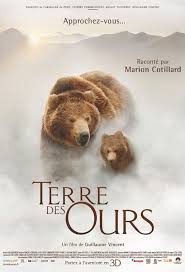
LAND OF THE BEARS
France, 2013, 86 minutes, Colour.
Narrated by David Gasman.
Directed by Guillaume Vincent.
It is a 99.9% safe bet to say that most people have never and will never visit the Land of the Bears. And where is this land? Almost immediately, this interesting documentary tells us that it is in the eastern part of Siberia, the Kamchatka peninsula. Since most of us are not going to Siberia let alone this peninsula, watching The Land of the Bears is the next best thing.
This is a French documentary, unobtrusively filmed, the bears not looking at the camera at all (though there are some tracking shots where the crew must be in a boat gliding along photographing the bears) but a style of photography that captures the realities without drawing attention to itself.
We are introduced into a wintry landscape, snow melting on rocks, and the viewfinder opening up to a mountainous region, snow and ice-clad, a territory that looks isolated and undisturbed, that no human beings have ventured there. But there is life. We are told that there are 20,000 Bears, and as spring progresses, there is quite a deal of birdlife. At some moments, in the sea at the shore, there is some sea lions looking for fish to eat. And the fish available are salmon, swimming upstream so that they will spawn millions of more salmon, ready for the bears to capture them and devour them so that they will have full bellies and be able to go into their dens and sleep for eight months, hunger satisfied. This is a cycle of life, quite a vast and particular eco-system.
So, in we go to a den, and are introduced to a mother and her cubs, and learn that bears live solitary lives in general, and that after some seasons, the mother lets go of the cubs as they become adult bears and fend for themselves. At this stage, however, the mother cares for her cubs, finding them salmon, protecting them in times of danger. There are some moments of danger, the male bears being huge and dominant, territorial concerning the salmon that they are hunting.
Which means that the film covers the four spring and almost-summer seasons, where the bears come out and roam, spending most of their life in the water, waiting for the salmon to come, catching the salmon as they arrive, eating the salmon, (with some close-ups of how they eat, tearing skin, cutting into the flesh, and between those teeth and into the mouth).
In some ways, the film and its story is rather repetitive but there is a fascination at this opportunity of looking at the bears (longer snouts and faces than the bBears we are used to from the Americas – although the final credits indicate that a lot of the base equipment for this film was set up in Alaska, comparatively close by.
In the French version, Oscar-winner Marion Cottillard is the narrator. For the English language version, the narrator is David Gasman, who has a quietly low key and easy-to-listen-two voice, certainly not intrusive in any way, leading us more gently into the narrative and the life of the Bears. While there are some moments of feeling, especially about the young bears, some of them excluded by other cubs, possessive of their fish, and with the young male cub alerted to the female cub and gradually becoming aware of the mating instinct. But there is no sentimentality at all, with the functions of eating, swimming and surviving. There is a kind of anthropomorphic perspective, but it is not indulged in any way to make the cubs and their behaviour seem cute.
Land of the Bears was filmed in 3D and best to experience it that way. While it would look good in 2D, especially on the big screen, it would also look good in 2D on a television screen.
Devotees of nature films and films showing details of the lives of animals will not want to miss this one.